- Author Matthew Elmers [email protected].
- Public 2023-12-16 21:49.
- Last modified 2025-01-24 09:17.
The death of Admiral Stepan Makarov in Port Arthur became a symbol of the strategically inconsistent policy of the Russian state in the Far East and a turning point of the era
Restless Russian genius
This is how Alexander Lieven, the commander of the cruiser Diana during the Russo-Japanese War of 1904-1905, named Stepan Makarov on the pages of his book Spirit and Discipline in Our Navy.
Makarov was unusually talented and, moreover, not being too frequent in Russia, was also a tireless, even restless toiler. He left behind a very significant military-applied, oceanographic, technical and other scientific legacy.
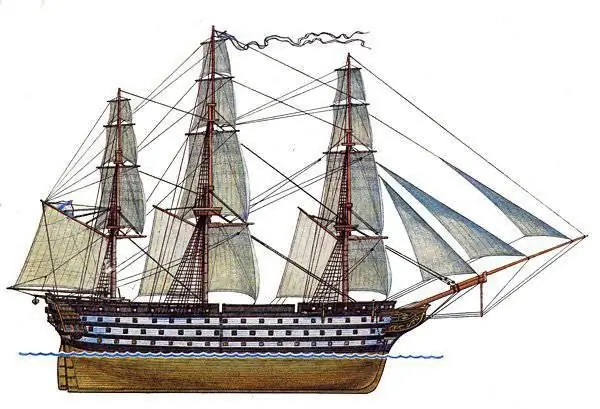
The battleship "Grand Duke Constantine". Source: shipwiki.ru
Stepan Makarov published his first serious scientific work "Adkins' instrument for determining deviation at sea" at the age of eighteen. And not just anywhere, but in the "Sea Collection" - the most authoritative scientific journal of that time.
In 1870, in the same "Sea Collection", Makarov suggested introducing a special plaster into the ship's damage control system, with which it is possible to quickly repair a hole in the ship's hull. In fundamental aspects, this technology, first proposed by Makarov, has been preserved to this day.
Later, already in the course of his systematic scientific activity in St. Petersburg, Makarov pays great attention to the theory of unsinkability of ships, in fact, forms a new scientific discipline in this discourse.
A huge layer of scientific and experimental activity of Stepan Makarov in the navy is the creation of torpedo weapons and special torpedo ships (at that time they were called destroyers, and torpedoes were self-propelled mines). During the Russian-Turkish war of 1877-1878, he managed to realize his ideas on the ship "Grand Duke Constantine", which was turned into the first mother of torpedo bombers in the Russian fleet.
The theory and practice of the combat use of torpedoes Stepan Makarov summarized in the brilliant, revolutionary for its time work "Rules for the night attacks of mine boats."
Makarov's three-year round-the-world voyage on the corvette Vityaz in the period 1886-1889 was completed with the capital work Vityaz and the Pacific Ocean. Then the saga of the creation of the first specialized Russian icebreaker "Ermak" and the fundamental oceanographic work on it in the Arctic Ocean followed.
It is curious that Makarov's main work on the use of naval forces in a major conflict - Discourses on Naval Tactics - was translated into Japanese in Tokyo just before the war. Chief Naval Commander Mikado, Admiral Togo, carefully read the book.
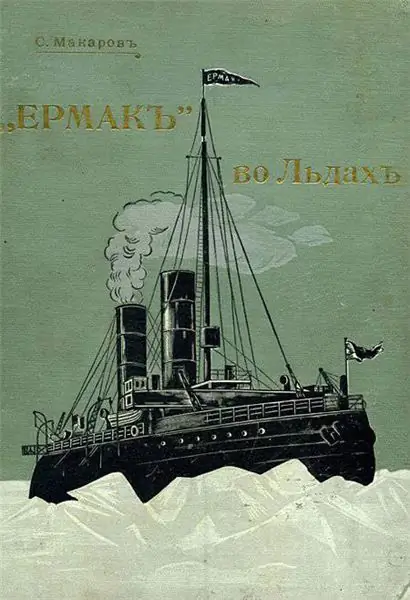
Cover of Stepan Makarov's book "Ermak in the Ice", 1901
Makarov lived, as befits every non-fighting citizen in Russia, very modestly. A very remarkable in this sense, his letter to his wife, sent from Harbin on February 19, 1904, has survived.
“I telegraphed Fyodor Karlovich [naval minister Avelan. - NL] about giving you 5,400 rubles, - the admiral wrote on the way to his last war. - Please, once again I ask you to save the money, I will not be able to transfer anything to you later. In the first two months, they will deduct the entire increase in salary from me, since I left you with a power of attorney for 1200 rubles. Month I will not get here onshore almost a dime. Only then will something start to remain, but we must save it."
I will not be sent there until misfortune happens there
Admiral Stepan Makarov wrote these words about himself and Port Arthur to his friend, Baron Ferdinand Wrangel back in 1903. If that year Makarov had been sent to Port Arthur to command the Pacific squadron, he would have had at least a little, but still enough time to look around, get up to speed, not drive his own health. Indeed, in December 1903, Makarov celebrated his 55th birthday. Alas, the Russian bureaucratic machine did not give Makarov even this little time to comprehend the tasks of the Pacific squadron and the methods of achieving them: "restless geniuses" are needed in Russia only during revolutions and serious wars with an external enemy.
In Russian historiography, Vice Admiral Makarov is traditionally considered an outstanding naval commander. However, the admiral's real track record testifies to something else: Makarov never commanded any of the fleets of Russia until 1904, he did not have the experience of a combat naval commander-practitioner. The admiral, due to his reputation as a restless reformer and a commander close to a simple sailor, was simply never appointed to high command posts.
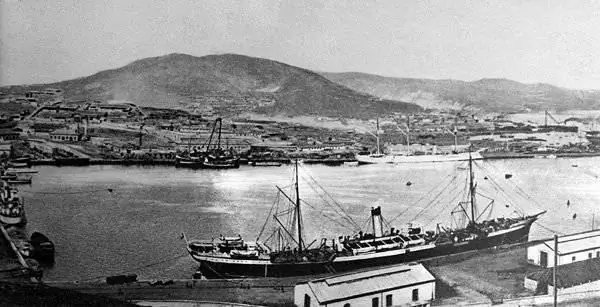
View of Port Arthur, 1904. Photo: RIA Novosti
Makarov went on ships a lot, even a lot, and mostly as a captain. Among the army of "armchair admirals" of Russia, he stood out as a real "sea wolf". But not even a fleet, but an expeditionary formation of ships - a squadron - Stepan Osipovich commanded only once in his life, and that was a very short time: from November 1894 to May 1895, that is, only six months. In fact, this was one naval passage of a squadron from the Mediterranean to Vladivostok, and only this transition exhausted Makarov's own experience as a naval commander.
It seems obvious that it was the lack of experience in real navigation in the changed conditions of the early twentieth century that became the main reason for the tragic death of Russian Admiral Makarov on March 31 (April 13), 1904.
Makarov in Port Arthur: first initiatives
Makarov arrived in Port Arthur on March 7, 1904. His charismatic leadership style was immediately felt by everyone. The admiral's adjutant would later write about these days: “Often we did not even have time for food or sleep; and yet it was an excellent life. What is especially characteristic of Makarov is hatred of routine, hatred of the old system of shifting responsibility to others, of attempts to avoid independence in action."
Makarov's struggle for the display of personal initiative by officers and sailors was de facto a struggle to change the entire traditional style of relations in the Russian fleet, built mainly on the sad maxim "I am the boss, you are a fool." Makarov could not really change the situation in a single month, which he commanded the Pacific squadron. However, significant shifts in the mobilization capabilities of the squadron were achieved.
Makarov's first event in Port Arthur was the organization of reliable communications in the fortress - without which, in principle, modern war is unthinkable: constant wire communication connected the headquarters with all the main weapons of the forts.
For the crews of the ships, difficult training days began: the fleet finally began to learn to shoot accurately, to quickly enter and exit from the inner raid of the base to the outer raid.
The entrance to the fleet base, in order to counteract the Japanese destroyers, was narrowed as much as possible: two old ships loaded with boulders were flooded on both sides of the port entrance, in addition, permanent minefields were exposed.
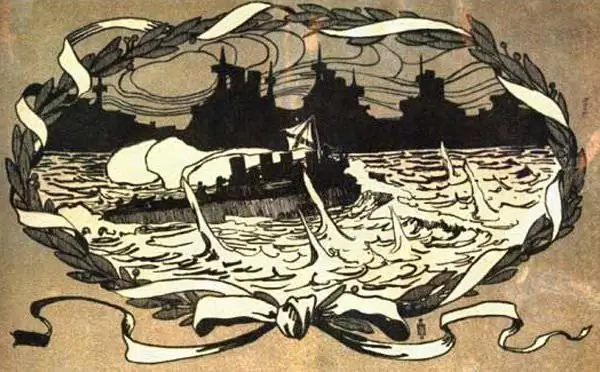
The death of the destroyer "Guarding", illustration from the poster for a charity concert at the Mariinsky Theater, 1904. Source: sovposters.ru
On the day of his arrival in Port Arthur, Admiral Makarov raised his pennant on the armored cruiser Askold. In the light of subsequent events, it seems that this first decision was correct: "Askold" was the newest ship (entered service in 1902), high-speed, maneuverable, very well armed. Its draft was almost three meters less than the draft of the battleship "Petropavlovsk", which later killed Makarov, in terms of mine protection it was a safer ship. Unfortunately, guided by, probably, an established tradition, Admiral Makarov soon transferred his pennant to the armored giant "Petropavlovsk".
Throw on the cruiser "Novik"
Admiral Makarov's leadership style is best characterized by numbers. In just one month of his command, the Pacific squadron went out to the Yellow Sea six times to conduct military operations against the Japanese fleet. And for the rest of the Russo-Japanese War, that is, in two years - only three times: once before Makarov's arrival in Port Arthur and twice under his mediocre successor, Rear Admiral Wilhelm Witgeft.
The first clash of Russian ships with Japanese ones took place on March 9, 1904: four Russian destroyers took up a battle with four Mikado destroyers. This battle ended in a draw. However, the next naval battle ended not in favor of the Russians.
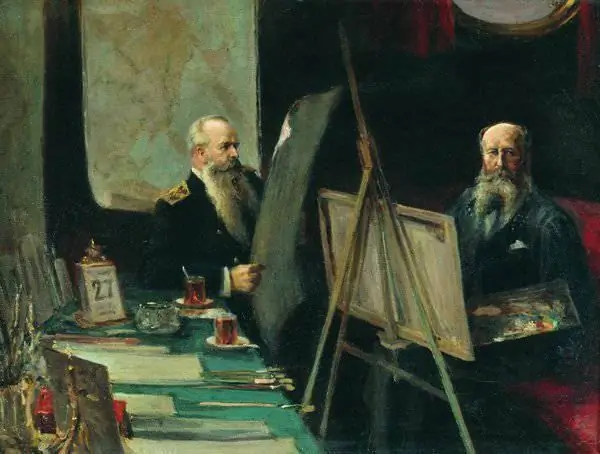
Eugene Capital. "Vice-Admiral S. O. Makarov and battle-painter V. V. Vereshchagin in the cabin of the battleship" Petropavlovsk ", 1904"
In the early morning of March 10, 1904, the destroyers Resolute and Guarding, returning to the base after a night reconnaissance flight, encountered a detachment of Japanese destroyers Akebono, Sadzanami, Shinome and Usugumo.
Russian ships tried to break through to Port Arthur, but only the Resolute succeeded. The destroyer "Guarding" was hit by a Japanese shell, lost speed and was forced to take its last battle. The commander of the "Guarding", Lieutenant AS Sergeev, who took command of him, Lieutenant NS Goloviznin, and warrant officer KV Kudrevich died heroically at their posts.
Having suppressed the firepower of the destroyer, the Japanese brought a towing cable onto the ship, but at that time the smoke of Russian cruisers appeared on the horizon: "Bayan" and "Novik" went to the rescue of "Guarding". The Japanese threw off the cable and, not accepting the battle, left. At about nine o'clock in the morning, the wounded "Guardian" sank. During the retreat, the Japanese raised four surviving Russian sailors from the water. All of them survived in Japanese captivity, and upon their return to Russia they were awarded the St. George's Crosses.
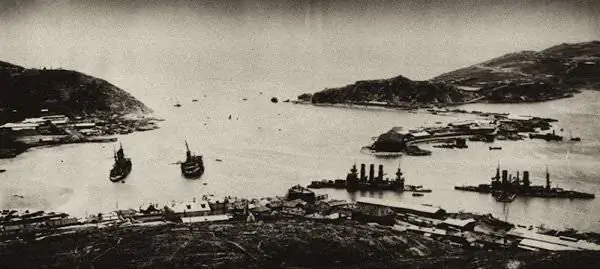
Inner roadstead of Port Arthur, 1904. Source: wwportal.com
Makarov himself took part in the raid to save the "Guarding" on the small armored cruiser "Novik". One can give credit to the admiral's heroism, but it is unlikely that a hasty personal exit to the sea on just two ships corresponded to the strategic interests of the Russian naval defense in Port Arthur. In this area of the sea, in addition to the four Japanese destroyers, there were already two Japanese cruisers "Tokiwa" and "Chitose", and most importantly, the main forces of the Togo squadron were on the way. Makarov clearly took an unjustified risk, endangering not so much his own life as the strategy of defeating the Japanese fleet.
Unfortunately, unjustified risk became Makarov's trademark in Port Arthur.
Admiral Makarov, probably not because of the good organization of the work of his headquarters, was often forced to combine the work of a designer, treasurer, junior lieutenant, adjutant and radio engineer. Remaining with all that also the chief strategist of the Pacific squadron.
The replacement of the planned work of the staff officers with their own impulsiveness and energy, so characteristic of Makarov, found, of course, a warm response in the hearts of the sailors, aroused genuine respect for the commander. However, the physical and moral fatigue of the admiral, which became the inevitable consequence of this annoying substitution, was, it seems, the main prerequisite for the tragedy of March 31, 1904.
The sleeping fire is excited
Among Japanese sailors, Admiral Togo Heihachiro received the informal name "Sleeping Fire". He, like no one else, knew how to control himself, but all the officers who knew him closely were confident in the admiral's incredible inner energy, in the latent fire of military passion boiling in his chest.
The sharp increase in the activity of the Russian Pacific squadron greatly alarmed Admiral Togo. The combat potential of the Japanese army on the mainland was entirely dependent on naval supplies of manpower, equipment and ammunition from Japan. If the Russian squadron managed to organize a systematic raiding, and this is exactly what its admiral was aiming at, Japan would have lost the war without starting it in full force.
According to the famous military historian A. V. Shishov, already in the second half of March 1904, at the headquarters of Togo, it was decided to concentrate efforts on mine warfare, making it its main goal to undermine the most combat-ready ships of the Russian squadron.
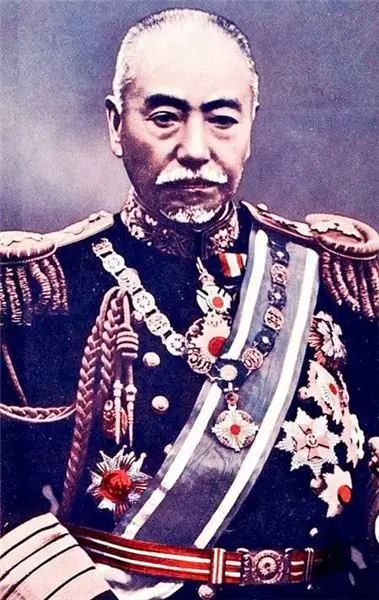
Admiral Togo Heihachiro. Source: sakhalin-znak.ru
The intelligence work of Japanese intelligence, as already described in the RP, was organized at an exceptionally high level, including in Port Arthur. Experts believe that intelligence data allowed Japanese specialists to very accurately determine the location of the mine bank. In principle, any Russian ship could have entered this minefield, but the flagship battleship Makarov, which always led the formation, was the first to enter it.
The narrow exit from the inner roadstead of Port Arthur set for Makarov the task of achieving such a cruising regime under the protection of coastal batteries, which would provide an opportunity to fire from ships while concentrating the forces of the squadron. This is how the famous "Makarov Eight" arose, which the Russian ships leaving the inner roadstead described opposite a strictly local area of the coast - from the eastern rumba of Krestovaya Mountain to the southern rumba of Mount White Wolf. The good thing about the Eight was that, in any evolution, each Russian ship could fire with one full side. Its weakness was in the absolutely formulaic, repeated from time to time cruising route. One had only to block the main reference points of this route with mine banks, and the undermining of the most deeply seated Russian ships became inevitable.
There was, however, an effective "antidote" against mines - high-quality, methodical work of minesweepers, fortunately the limited, virtually permanent route of the G8 sharply narrowed the scope of work.
Premonition of death
On the eve of his death, Admiral Makarov sent his son Vadim the only letter from Port Arthur. This almost mystical message is worth pondering not only about how special the relationship between the admiral and his son was, but also about the secret of God's will.
“My dear son! This is my first letter, sent to you, and not in fragments in letters to my mother, as it happened before. You are already a teenager, almost a young man. But I am addressing you from the other end of Russia as an adult man. I am sending the letter to my old friend in Kronstadt. He'll find a way to put it in your hands. There is a fierce war going on here, very dangerous for the Motherland, albeit outside its borders. The Russian fleet, you know, did not work such miracles, but I feel that you will not tell anyone yet, that we, including me, as if something is interfering - not Admiral Togo, no, but as if from the side push, as if sneaking up from behind.
Who? Do not know! My soul is in a confusion, which I have never experienced. I am already beginning to catch something, but vaguely so far. Here Vereshchagin Vasily Vasilyevich is trying to explain something, but confusedly, like all artists and poets … This is my mood, son. But you know about it while you are alone. Be quiet, as a man should be, but remember."
Togo stood almost breathless
On the eve of March 31, 1904, Makarov slept badly. His adjutant testifies that for several days in a row the admiral practically did not take off his uniform - apparently, he was tormented by insomnia.
Another eyewitness wrote about this night: “… In the beams of the searchlight of the Krestovaya mountain, silhouettes of several ships were outlined, our searchlights" missed "them for about two miles. Particularly disturbing to make out what was the matter, the mesh of fine rain, illuminated by searchlights. It seemed that the suspicious silhouettes were either standing still or wandering back and forth in the same place."
Today it is already known that the mysterious "silhouettes" were the Japanese mine cruiser "Koryo-maru", which carried out a large-scale mine setting at all reference points of the "Makarov Eight". A total of 48 minutes of deep detonation were set.

The death of the battleship "Petropavlovsk". Source: roshero.ru
At night, Makarov was informed about the discovery of unknown ships in the outer roadstead. Why, in order to report on such a private, in fact, an event had to be lifted from the bed of the commander, and not his deputy on duty, remains unclear.
Makarov did not give permission to fire coastal batteries at the "silhouettes": a detachment of destroyers sent to reconnaissance of the Japanese forces near the Elliot Islands was in the sea. The admiral was afraid to fire at his sailors. It also remains unclear why the destroyer commanders did not receive the code of the searchlight signal "I am mine", which they were obliged to give when approaching the external raid, in a timely manner.
On the morning of March 3 (April 13), 1904, Admiral Togo's plan to lure the Russian fleet out of the internal raid of the base began to be implemented.
Six cruisers under the command of Admiral Dev approached Port Arthur. They imitated one detachment that had gone far from the main forces. Togo was at the head of the squadron battleships at that moment only 45 miles to the south. Another group of ships from Admiral Kamimura was waiting for the Russians off the Korean coast, in case they decided to break through to Vladivostok.
When Makarov was informed about the approach of the Japanese cruisers, he allegedly gave instructions to immediately wipe out the exit from the inner roadstead and the water area of the G8 with mine trawls. Why this absolutely obligatory event was not carried out is again unclear. Perhaps, the lack of professionalism of the Russian staff officers again affected, but it is no less possible that the order was canceled by Makarov himself.
In an incredible haste, the Russian ships began to leave for the outer roadstead. The battleship Petropavlovsk led an armada of four battleships, four cruisers and nine destroyers.
Makarov, in his famous old - "happy" - jacket with a fur collar was on the bridge. Not far from him stood the Russian painter Vasily Vereshchagin, a representative of the Romanov family in Port Arthur, Grand Duke Kirill, captain of the schooner Manzhur Crown.
At 09:15, Admiral Makarov saw the battleships of Togo through the telescopes. The Japanese commander, in turn, clearly distinguished the huge Russian flagship. Staff officer Kure Kosigawa, who was standing next to Togo, later noted in his memoirs that Chief Admiral Mikado "was so unnaturally motionless that he seemed lifeless." That painfully, like a "sleeping fire", was waiting for something.
At 09:43, Togo saw a colossal explosion on the horizon, throwing a volcanic column of greenish-brown smoke to a height twice the height of the masts. Many Japanese officers took off their caps. Togo gave the command to lower flags on all ships, and to all officers to put on signs of mourning. The "Sleeping Fire" paid tribute to his dead enemy as a true samurai.
“Suddenly the stern of the battleship rose straight into the sky,” Lieutenant Semyonov, an eyewitness to the death of Petropavlovsk, testified with a shudder. “It happened so quickly that it didn’t look like a sinking ship, but as if the ship suddenly fell apart in two …”.
The squadron battleship "Petropavlovsk" sank in just two minutes. The reason for this is in the extremely dangerous place of the mine detonation: just opposite the artillery cellar of the main caliber - the entire ammunition detonated, boilers exploded behind it.
Together with Makarov, the artist Vereshchagin died, as well as 635 officers and sailors. Grand Duke Cyril was picked up from the water, and another 80 crew members were rescued with him.
“Something more happened than just the death of Makarov,” writes contemporary researcher Anatoly Utkin. - Fate began to turn away from the country, which has come such a long way to the Pacific Ocean. From this time on, the fog of doom begins to envelop Russia in the Far East. The former euphoria of the young giant will never return.”
The Japanese poet Ishikawa Takuboku, shocked by the mysticism of the unexpected death of the Russian flagship, wrote heartfelt lines in 1904.
Friends and foes, throw away your swords
Do not strike violently!
Freeze with your head bowed
At the sound of his name: Makarov.






